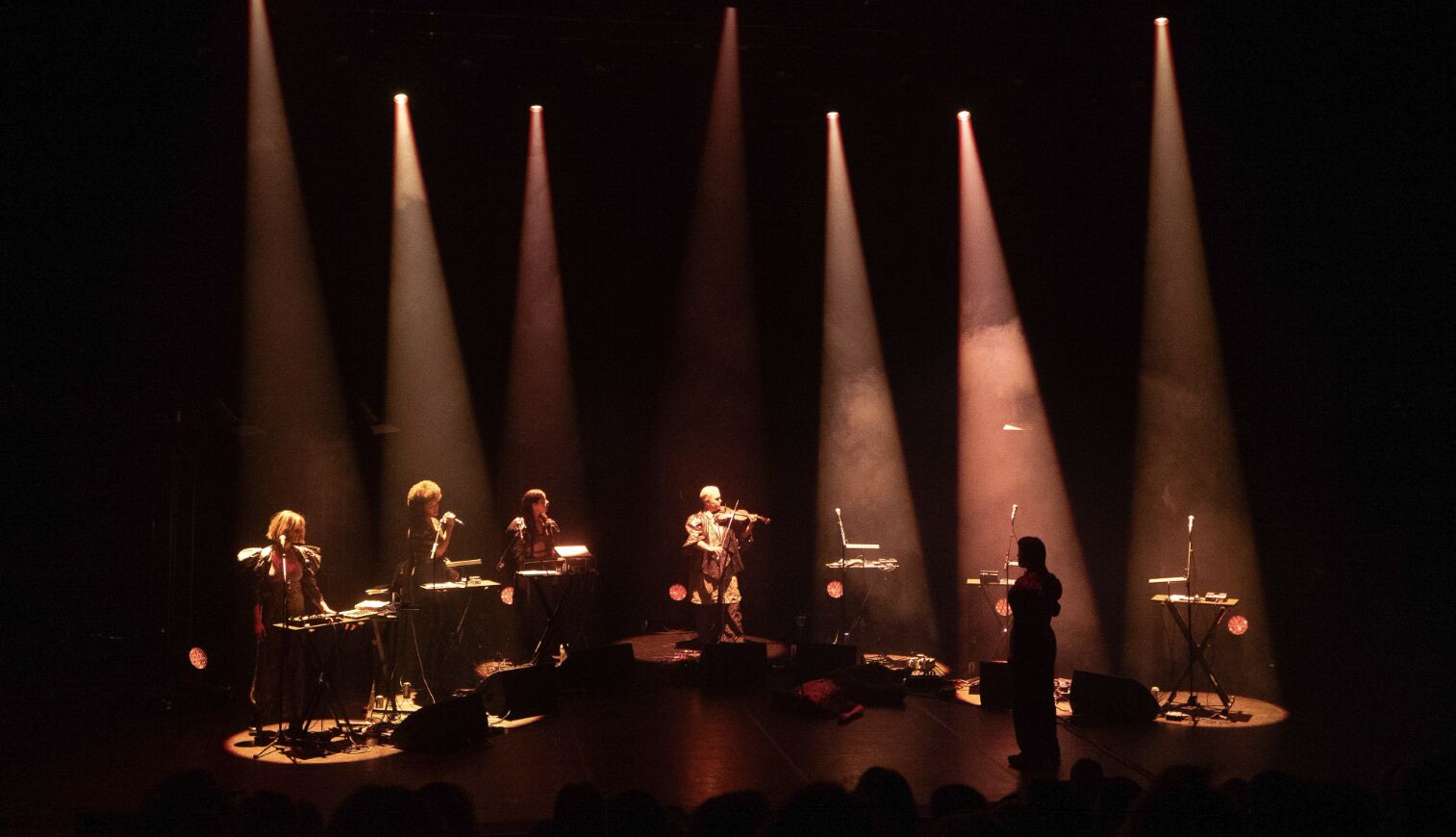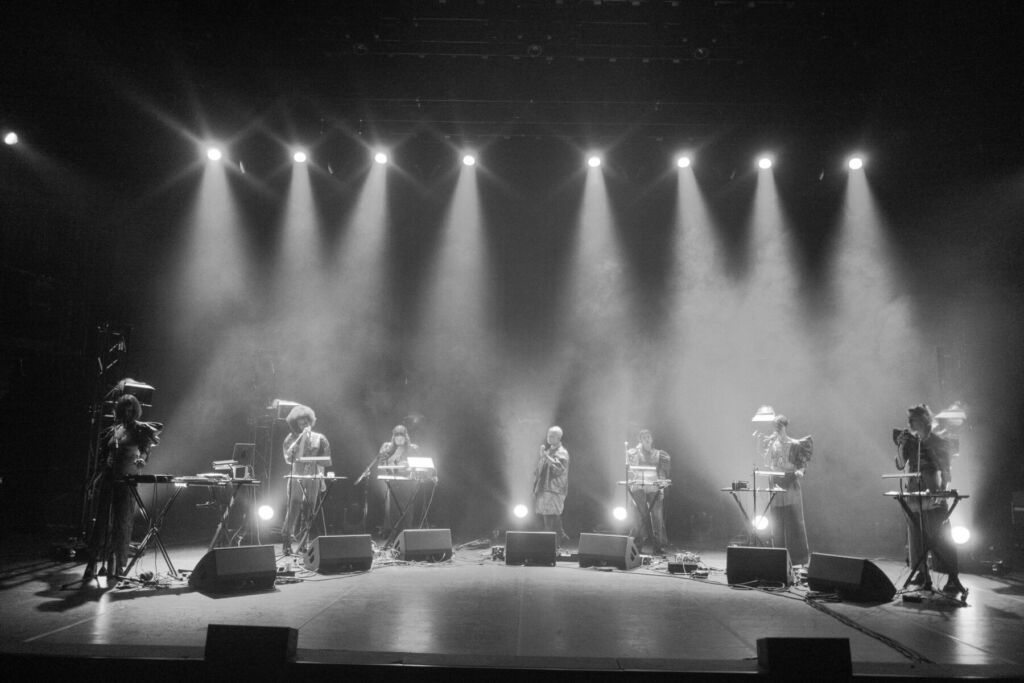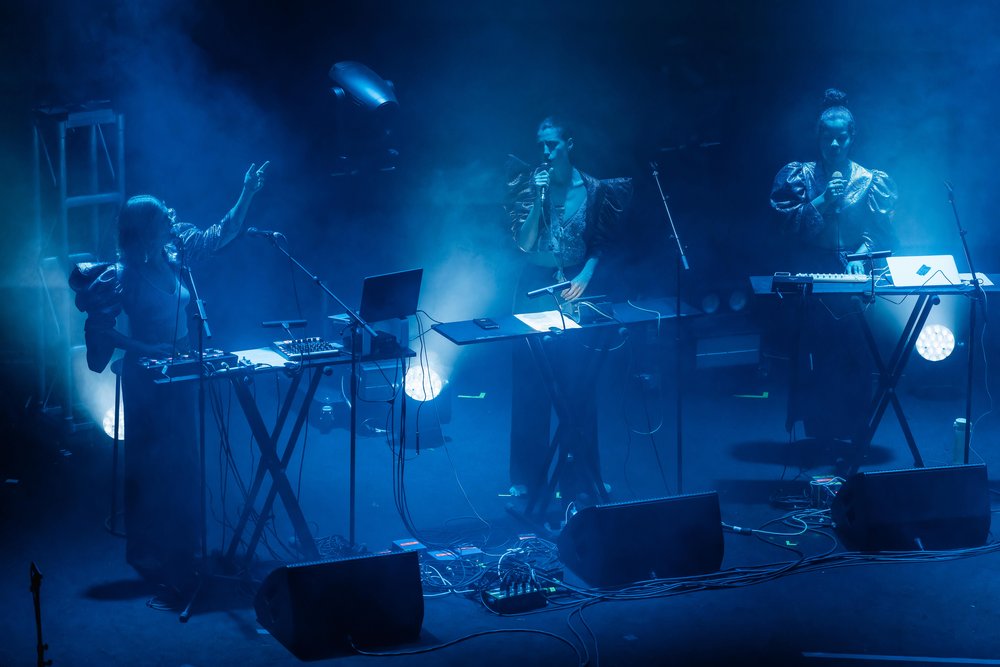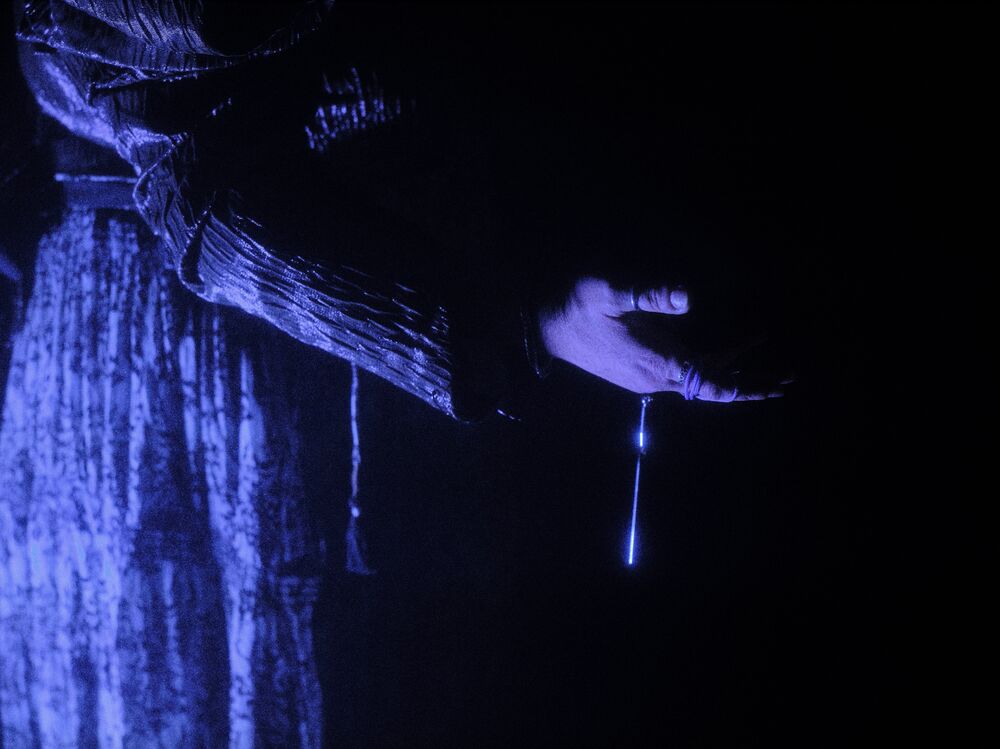Interview by Luca Nasciuti

NYX are a collective working with live electronics, drone and choral sound. Their work often includes collaboration resulting in productions such as Deep England with Gazelle Twin featured in the Guardian’s top ten contemporary albums for 2020, the 2021 A/V project and EP with Laura Misch and James Bulley’s Trees: Songs of Epping Forest alongside films by Matthew Rosier and the lockdown remote collaborative album Mutualism with words by MA.MOYO and a side remix EP with contributions by Deena Abdelwahed, Anna Wall and LCY.
The choir presented a new project at the Southbank Centre’s Queen Elizabeth Hall in February 2024, developed within the Southbank Centre Studio initiative in 2023 and supported by Hawkwood College, The Francis W Reckitt Arts Trust and the PRS Foundation. NYX Live was co-produced with electronic music producer Vessel (Sebastian Gainsborough) with costume design by Tom Scutt and somatic movement direction by Imogen Knight.
Live music is an aspect of a musician’s work that sets itself apart from the time composing and producing in the studio. Live music is that organic moment in time shared with an audience when artists move from private (the studio) to public (stage). It is a time of vulnerability, risk-taking and communion. Anything can happen on stage. It can be incredibly energetic and nurturing. But performing can be very stressful and touring, exhausting. The audience experiences the music during a live performance and feels the stage. The performer is exposed to a polar power dynamic. On the one hand, there is the thrill of the act, the show, and the idolatry a crowd produces when staring at the stage. However, the audience also examines and collects the pouring of energy from the live artist, and this process puts a great strain on the latter.
With wordless utterances, extended vocal techniques, structured melodies, electronic soundscapes, recordings and earthy bass, the collective choreographed lights and themselves with the music and delivered an enigmatic, emotional and very physical experience at the Southbank Centre. As an audience member myself, I found it captivating to feel the stage extend into the auditorium. The collective wore green and grey costumes that reminded me of camouflage clothing. They moved into and away from the spotlights placed above and behind them, allowing the audience to see them emerging from and retreating into the shadow. Often, the bodies were backlit, and their physicality, therefore, blurred.
Only hints, shapes, and masses were visible. Just like the sound masses that rolled out of the stage into the audience, invisible streams of grains and punctures pricked our skin and made their way into our bodies. It was a transfer of energy induced by the complex soundscape of evolving fragments of vocal and instrumental lyrical melodies, guttural utterances and clicks, and abstracted electronic manipulation. Although highly staged and choreographed, the interaction between members highlighted the improvisational nature of their production and the communal ethos of collaboration and care for each other. Like the ever-present and physical bass that sustains rhythmic and melodic patterns in their music, their relationship was visibly transported to the auditorium.
Communion seems to best describe NYX’s work. From its conception in the studio to rehearsal, improvisation, collaboration, and performance, this female drone choir confirms an ethos of sharing, openness, support, engagement and care.



NYX is defined as a drone choir and perhaps I would like to start by unpacking this term. Your music strikes me as something rather different than drone music. It is defined by complex layering, repetition, a strong sense of phrasing and dynamics. How does this complexity relate to drone practices that perhaps tend to emphasise slowness, density and very static motion?
Sian O’Gorman (NYX Music Director): Our relationship to drone exists more as an evocative anchor point to where all the musical layers are born through. Each piece is composed from some kind of holding/repetitive/deep tonal vibration – maybe a layered hum/vocal drone/breath wind loops/waves of field recordings or bed of affected strings. Then like many forms of drone music, murmurations and branches of melody start coiling out from the centre and shapeshift into a different space. We often just push this into a much more climactic and dynamic space than more traditional forms of drone will go. But at the essence of all pieces, you will find some kind of carry-through or holding from the centre of the sound.
The richness of your music alone is perhaps defined by the way electronic sound, manipulation, melody pattern repetition and arrangement develop. Voices sustain and reinforce each other, manipulation offers context for melodies to emerge and move the narrative forward, while heavy sub and basslines anchor the voice to the ground offering a deep sense of grounding for the listener. How has your compositional strategy developed and changed over the course of the past few years given how prolific you have been in a relatively short time?
Sian O’Gorman: I think the main thing for me as a composer that has evolved over these last few years is the expansion of the timbre and possibilities of sound textures that I have constantly diversifying and blossoming at my fingertips. This has come through the many collaborations with multidisciplinary artists, the many embodied voice workshops leading us to new voices and extensive connections with improvised human sounds, and my own discoveries with vocal effects technology (particularly through the deepening relationship we have with Ableton).
Each time I start a new project I try to dive in through the means of a new sound palette based on the brief of the work or the intention behind the piece. I really love working with stimuli from related creative disciplines – film/imagery/literature as a form of imagination to feed into the sound. The majority of our work revolves around themes in nature, so I will work to say, a video of the inside of a crystal, or a projection of a forest, or a poem from the outer orbits of our solar system and soundscapes will come through from there.
I appreciate a great number of genres in your music. Can they be perhaps called influences? It is not a term I am very fond of as it somehow strips away an identity to the music by making it part of a world that already exists, and your work is anything but this. One can recall folk traditions, minimalist and neo-classical approaches and extended vocal techniques that often appear in your phrasing to then dissipate into a new form. I would tend to use the word ‘shapeshifting’ to try and describe this tendency. What is your relationship to music genres, music composition strategies and your own sonic identity? How do you navigate and negotiate a collective identity while collaborating with your members and other artists?
Sian O’Gorman: I’d say we are definitely fed from a huge sphere of different sound and musical influences from all around us, many of the forms you’ve mentioned above and many more – we’re also deeply entranced with doom metal, techno, punk of all shapes and sizes, beautifully engineered pop, early renaissance music, sacred song, epic cinematic scores, fantasy film music – there’s actually not a lot of musical genres we wouldn’t welcome into our cauldron of sound, as all of our individual musical languages are built up by such a vast array of influence and learning traditions. I think what makes us unique is that our vocalists come from a multitude of sound and art worlds – some of them are trained singers and others started out as sound and visual artists, so each of them brings a unique expression of how their bodies interpret sound to the performance and the compositions. We seldom use lyrics – preferring the sounds to speak for themselves and to be interpreted in a unique way by the listeners. I would say the uniqueness of our sound (whilst being influenced by these many worlds) does come from our approach to sound as coming directly from and through the body – we’re tapping into a primal state of sound-making and then twisting and filtering this through various technologies, but the essence is always from the human body itself.
With the voice often comes the word. Lyrics are not the centre of your music; vocalisation and utterance are centre-stage when lyrical moments are pushed to the foreground. What’s your relationship to songwriting and writing lyrics?
Sian O’Gorman: I always hear music more as colour, shapes, and sounds – I was always one of those who misinterpreted pop lyrics because I’d only hear the phonetics. I really struggled in classical music school with learning words in any language – I had to go through quite a rigorous method of attaching the sounds to the word shapes.
But I think that’s because so much traditional music training does seem to be devoid of any actual connection to meaning or a deeper truth – we were taught technique first and then were asked to slap on the emotion after – so I’d struggle to learn lyrics through any form of meaning.
So, this project felt more like an exploration of the voice as an instrument—sounding over “singing.” This process of not using lyrics (most of the time) gives me a sense of freedom to create less literal/linear worlds. And when we do use lyrics, we play into the articulations and shaping of the vowels and consonants—as much expression through the spaces inside the words as possible.
What is your relationship with the soundscape? On the one hand, I appreciate the textural complexity of your vocal, instrumental, and electronic sound, which can be read as abstract or abstracted ‘soundscape’ within the electroacoustic tradition. Still, your work also has an aspect of environmental inhabiting that directly engages with recorded environmental sound, field recording and the soundscape. It is another layer that directly affects your production, such as in your collaborative 2021 release with Laura Misch’s Songs of Epping Forest or the field recordings embedded in your latest Southbank performance.
Sian O’Gorman: My relationship to composition is incredibly visual and feels more like a sonic landscape than it ever does a song. Our structures seem more relatable to patterns in nature, and they flow more like dreams and meditations – both in how they are composed and how they are performed. We tread a line between organic, embodied improvisation and well-rehearsed harmonic ebbs and flows. The integration of field recordings adds a further layer to deepen and respond to on stage and in the studio – they act both as an inspiring force/anchor point in the composition but also as another entity on stage to integrate and work with.
There is a strong sense of embodiment from the stage of production to performance. Perhaps the most effective act I witnessed at the Southbank was how members gravitated around the microphone and distanced themselves from it. The relationship with the microphone is very theatrical, raw and visceral when it is sung into or when the performer’s body stands behind a stage backlight or lies on the floor. How does the stage affect your production as well as your delivery? How is improvisation, as a practice often employed in your work, negotiated within a choreographed, timed experience?
Philippa Neels (NYX Creative Director): Everything starts from the body. Before we sing together or use our voices in any capacity, we connect our breath, muscles and bones. Performance styles are developed from extensions of each performer’s instincts, using the energy of tension, release, adrenaline, fear and joy rather than a prescriptive performance style.
Our Embodiment Director, Imogen Knight, invites performers to tear up the rulebook of staging performance, encouraging them to depart from the group, move into the shadows, turn their backs to the audience and lie on the floor to bathe in the sound when that’s what they feel they need to do to deeply engage with the music as its being created.
Like our music, there is a structure to improvise around while allowing each performance to be a unique experience for the audience and performers. This sense of liveness is what we thrive on.
As your collaborations grow and develop alongside your own experience as a female choir, how would you define your experience of carving your space in a relatively short time? What were the biggest challenges in promoting your aesthetics and vision within the restraints and conditions of a precarious music industry dominated by gender inequality and where creative freedom is often a synonym for financial hardship?
Philippa Neels: Our choir is a modular collective held together by the practices and collaborative networks of over 50 talented individual artists. As a choir, we can instigate our own work but also quite naturally expand the sonic and performance scale of other artists’ projects. We’re all exhausted by competition and find strength and renewed energy in building an interdependent community.
We have always worked across different art forms (music, installation, theatre, film, video games, TV), giving us a more resilient income and business structure than if we had gone down a more commercial music route. 60% of our work is administrative, and we invest a lot of time in building partnerships with artists, organisations, and funders. Most projects take about three years to complete.
What do you think are the challenges to creativity and creative processes today?
Philippa Neels: A violent disconnection between our bodies, our brains, each other and the environment. We need to rediscover what it means to truly listen.
And lastly, what could you not live without?
Sian O’Gorman: Connection and belonging – the main thing that drives our desire to expand NYX is the real creative human connection we all crave and long for.





